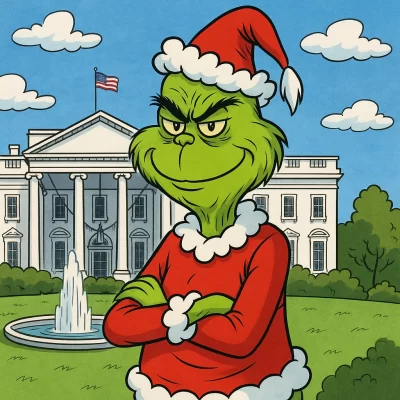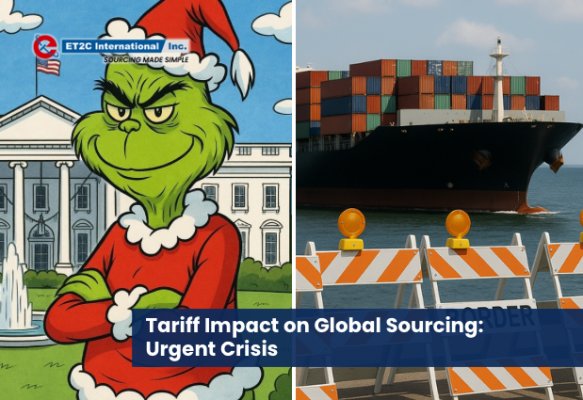Tariffs, Trade and Global Sourcing: Any stocking fillers this Christmas?
As the calendar ticks past one month since the U.S. introduced a new wave of tariffs on Chinese goods—an act many are calling the “Liberation Day” of the latest trade war—the economic consequences are beginning to take shape. This coming week is pivotal. With neither side backing down, and tariffs climbing steeply, global supply chains are buckling under the pressure, and the consequences for both the American and Chinese economies could be severe. The lead-times for product and shipping require Christmas and Halloween products to be planned and ordered to avoid empty shelves in the festive season.

Tariff impact on global sourcing : A Supply Crisis Brewing in the U.S. Market
At the heart of the U.S. economy lies a vast network of retailers and e-commerce businesses—ranging from the giants like Walmart, Lowe’s, and Home Depot, to tens of thousands of small and mid-sized sellers relying on Amazon, Etsy, and Shopify. Many of these companies depend heavily on sourcing from China, where manufacturers offer low Minimum Order Quantities (MOQs) and rapid turnaround times—something most other countries, still reliant on Chinese raw materials themselves, cannot yet match.
The new tariffs have triggered a chilling effect. In the last week, reports from major shipping logistics firms show a dramatic slowdown in the volume of goods being routed to U.S. ports. Simply put, many companies are opting not to ship goods due to the unsustainable cost implications. What does this mean for the U.S. market?
A sudden and severe shortage of goods is likely. While major retailers still hold ample stock from pre-tariff shipments, inventory turnover cycles mean depletion is imminent. For seasonal products—especially Halloween decorations and costumes, which should already be en route—the clock is ticking. Christmas products, many of which are held in limbo or just beginning production, face an even tighter deadline. If tariffs remain in place, expect not only shortages but significant price hikes as companies try to offset the additional costs.
The E-Commerce Crunch
Perhaps the most vulnerable sector is the American e-commerce landscape. Businesses that built their brands by global sourcing of unique, low-MOQ products from agile Chinese factories now face a no-win scenario.
Many cannot afford the tariffs. Paying up to 50% more on landed costs is not an option for small retailers operating on tight margins. These sellers, without domestic supply chain alternatives, risk being wiped out. Thousands could be forced to shutter operations in the coming months—not for lack of demand, but for lack of inventory.
Even larger operations that weathered COVID-19 supply disruptions are finding this tariff wave harder to absorb. Unlike pandemic-related delays, tariffs are a direct cost, not a logistical hurdle. Importers are now faced with a painful choice: raise prices dramatically and lose customers, or halt imports entirely.
Global Sourcing Strategies to mitigate trade turmoil
ET2C International are a British owned global sourcing company with over 23 years experience helping our clients to make their sourcing simpler. Our 200 colleagues are based in 7 global offices giving you rapid and insightful access to:
- China
- Vietnam
- India
- Turkey
At times of global trade turmoil having teams on the ground to support you company are vital to defend your margin and product supply. To learn more about the sourcing opportunities in alternative markets for your business contact@et2cint.com to talk to one of our colleagues.

China’s Factories Are Feeling the Squeeze
The shockwaves are reverberating across China, too. Although the country’s manufacturing engine is vast and diversified, many factories are now grappling with stalled production lines. Some orders are in limbo—paused mid-way due to buyer hesitation—while others are being held at warehouses, awaiting instruction as the tariff fog thickens.
In April, Bloomberg reported a surprising surge in Chinese container exports—perhaps a last-minute dash by U.S. importers to get ahead of tariff hikes. But as May begins, that momentum appears unsustainable.
Chinese factory cash flow is under pressure. Many operate with slim margins and rely on a constant churn of export orders to meet payroll. It’s common in parts of the Chinese manufacturing sector—especially in Guangdong and Zhejiang provinces—for workers to be paid per completed item. If orders dry up or remain frozen, workers go unpaid, and labor unrest could follow.
Already, industry analysts in Shenzhen report that smaller workshops are laying off staff or shortening shifts. The tariff standoff is not just a political maneuver; it’s threatening the economic fabric of entire industrial communities in China.
Tariffs: A Weapon That Cuts Both Ways
With tariffs now so high on both sides, trade is at a near standstill. The intent, it seems, is not purely economic but strategic—forcing both countries back to the negotiation table. But as every day passes, the price of political brinkmanship grows.
Neither Washington nor Beijing will collect meaningful revenue from these tariffs if no goods are moving. The current impasse is not just costly—it’s counterproductive. And behind the scenes, pressure is building.
This weekend, a glimmer of hope: the U.S. Treasury Secretary and China’s lead trade negotiator are set to meet in Switzerland. The meeting is described as preliminary, but its significance cannot be overstated. Both nations are staring down the barrel of a trade-induced economic slowdown, and both are acutely aware of the political fallout that could follow empty shelves and angry consumers.
One potential outcome: a temporary suspension of tariffs in good faith, while deeper negotiations resume—echoing the feverish diplomacy of the first Trump presidency. This could offer a lifeline to businesses caught in the crossfire and stave off the worst of the looming crisis.
The Political Optics: An Administration Under Pressure
The Trump Administration is walking a tightrope. Tariffs can play well in political messaging—signalling toughness on China and protecting American jobs—but they carry risks. The average consumer is not following the nuances of global trade. What they will notice are higher prices, delivery delays, and empty shelves.
And as holiday seasons approach, the symbolism becomes sharper. Halloween without costumes, Thanksgiving without decorations, and a Christmas with barren toy aisles? The optics could be devastating.
Conclusion: A Grinch in the Trade War
This next week could shape the future of U.S.–China trade for months, if not years, to come. The business community is watching closely, hoping for resolution—or at least a pause. Tariffs have already become more than just an economic issue; they are a political litmus test.
Will common sense prevail at the negotiating table? Or will both nations continue to escalate until the damage becomes irreversible?
One thing is clear: if no deal is struck, and if sourcing channels remain frozen, it may not be Santa Claus heading to the White House this Christmas—but the Grinch.
We remain here to help our clients, and get the visibility required to make your supply chain work for you. Please contact us for any queries about alternative markets outside China, or any other challenges you are facing. For more information, please contact us at contact@et2cint.com

